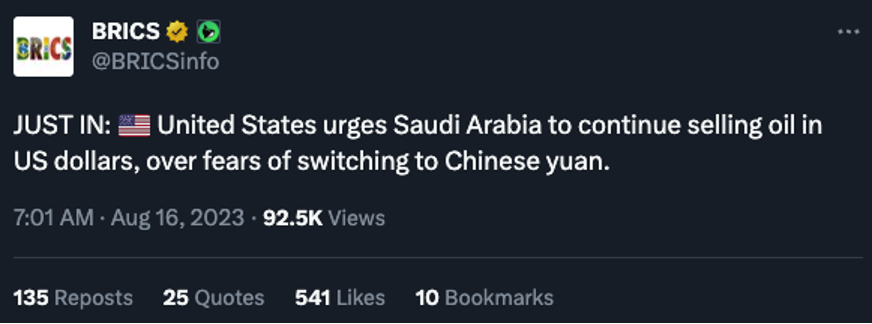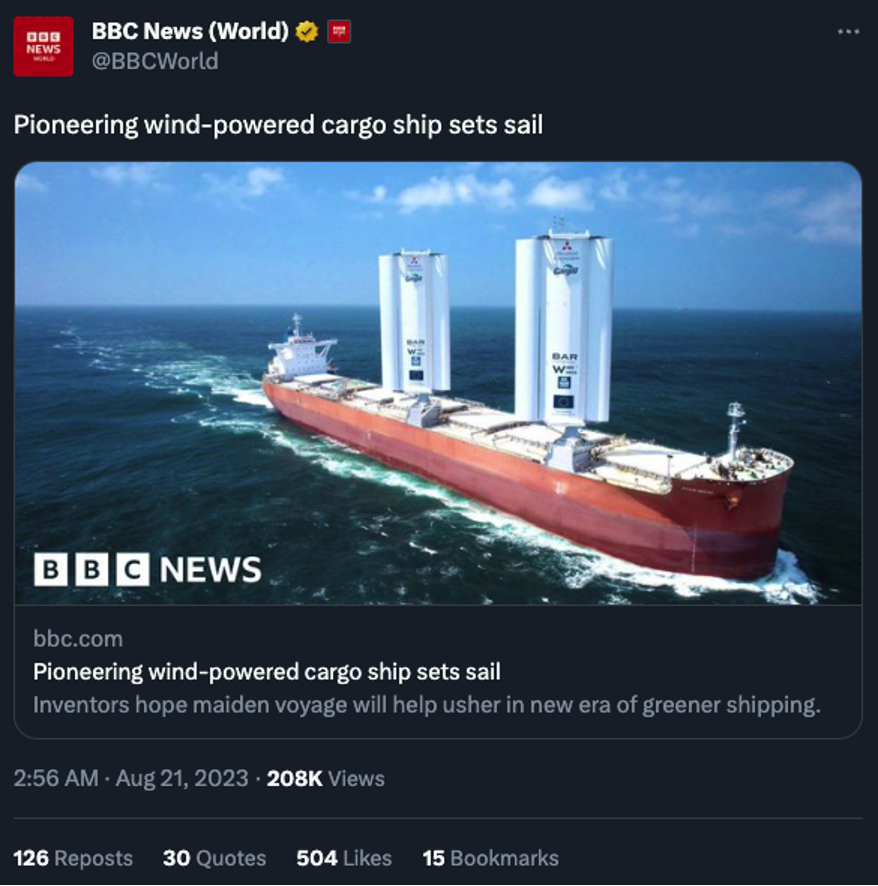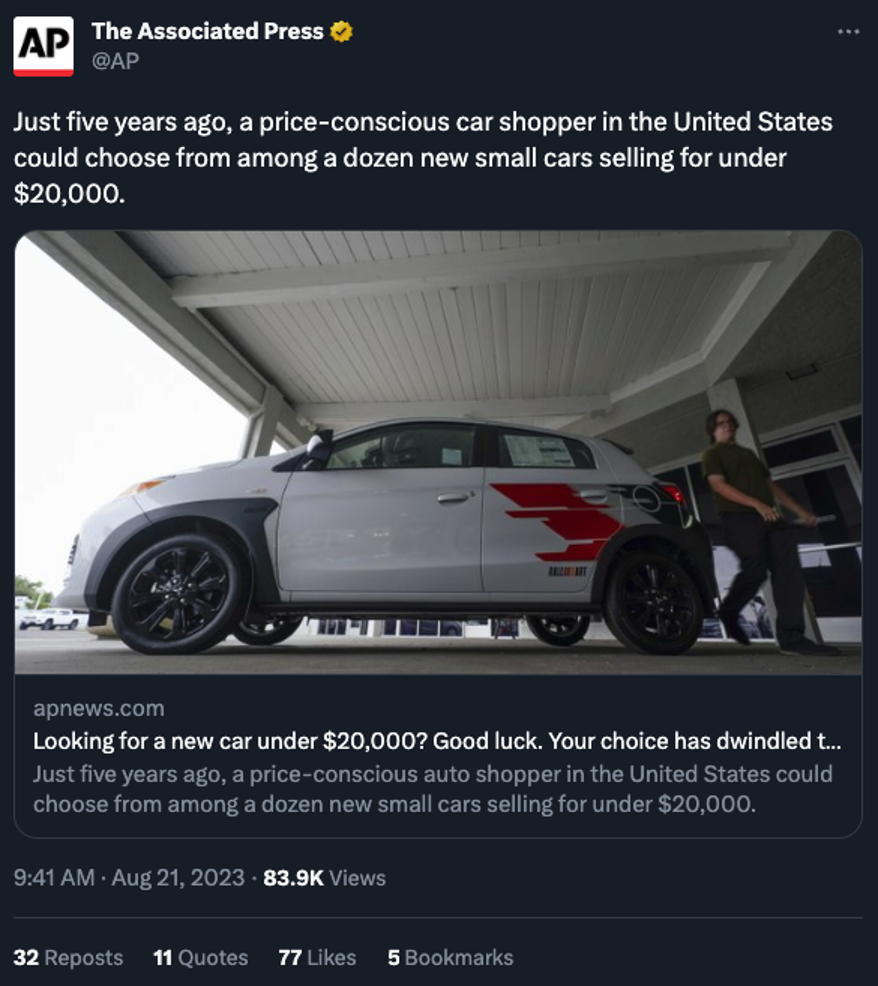Saudi Arabia Rising
- One day to BRICS: Myth and Reality
- So much for “stimmy” savings
- Plenty more upside for the oil rally
- A 21st century sailing ship
- The last “affordable” car.
![]() One Day to BRICS: Myth and Reality
One Day to BRICS: Myth and Reality
 With one day to go before the start of the BRICS summit, the noise and nonsense from both mainstream and alternative media is becoming deafening.
With one day to go before the start of the BRICS summit, the noise and nonsense from both mainstream and alternative media is becoming deafening.
“China will push the BRICS bloc of emerging markets to become a full-scale rival to the G7 this week,” says the front page of today’s Financial Times.
“But in the run-up to the summit New Delhi has clashed with Beijing over the expansion. Tensions are mounting over whether the BRICS should be a non-aligned club for the economic interests of developing countries or a political force that openly challenges the West, said people briefed on India and China’s positions.”
Of course, the FT is an organ of the Western power elite. It has every incentive to play down the prospect of the BRICS upsetting a status quo that’s made the elite very prosperous.
 Meanwhile, for the last week, there’s been a ton of misunderstanding and exaggeration surrounding this development…
Meanwhile, for the last week, there’s been a ton of misunderstanding and exaggeration surrounding this development…

In other “alt” outlets, we see this development described as “secret pressure on Saudi Arabia to keep selling its oil in U.S. dollars and to turn its back on Beijing.”
This is mountains-out-of-molehills stuff.
It all began a week ago today when The Wall Street Journal published a story about “the broad contours of a deal” between Washington and Riyadh for the Saudi Arabian government to establish diplomatic relations with Israel.
There were plenty of caveats sprinkled through the story about how it will take “nine to 12 months” to “hammer out the finer details” and that a deal still faces “long odds” — not least because there’s no love for Saudi Arabia in Congress these days.
Nonetheless, alternative media are keying in on this paragraph in the story…
The officials said the U.S. could seek assurances from Saudi Arabia that it won’t allow China to build military bases in the kingdom — an issue that has become a sore point between the Biden administration and United Arab Emirates. Negotiators could also seek limitations on Saudi Arabia using technology developed by China’s Huawei and assurances that Riyadh will use U.S. dollars, not Chinese currency, to price oil sales, they said. The U.S. also is expected to look for ways to end the feud over oil prices driven by Saudi Arabia’s repeated production cuts. [Emphasis ours]
That’s literally all the story says about pricing the dollar in oil.
Well duh. It’s not as if the White House would go to the trouble of forging a de facto alliance between Saudi Arabia and Israel… and then just shrug if Saudi Arabia goes and prices oil in yuan.
But alternative outlets eager to push the “instant dollar collapse!” narrative will latch onto any little thing to reinforce the narrative.
 Let’s pull some signal out of all the noise: If the BRICS conference moves markets this week, it will be because the group acts to expand its membership in general — and welcomes Saudi Arabia in particular.
Let’s pull some signal out of all the noise: If the BRICS conference moves markets this week, it will be because the group acts to expand its membership in general — and welcomes Saudi Arabia in particular.
Late last week, Paradigm macro maven Jim Rickards issued a special Q&A briefing to readers of Rickards Strategic Intelligence.
“If what I’m predicting takes place come Aug. 22,” he said, “Saudi Arabia will be accepted into the BRICS alliance (Brazil, Russia, India, China, South Africa). This in itself is a major power grab by the BRICS challenging the G7 countries.
“But if Saudi Arabia chooses to break the petrodollar agreement with America and sell its oil in currencies other than dollars… It will be a MASSIVE blow to America and could be what leads to the dollar losing its reign as the global reserve currency of the world, weakening America’s power even more.”
Little wonder Jim has been calling this week “Biden’s 9/11 moment.” No one will die or be injured… but the shock factor would be comparable.
Here’s the thing: Even if there’s no announcement about Saudi Arabia selling oil in currencies other than the dollar… Jim believes a BRICS-Saudi combo will set off “a currency war unlike anything we’ve ever seen… creating a massive profit opportunity in the currency markets.
“My proprietary IMPACT system has already identified three currency trades I believe are set to be the biggest winners of this new currency war.” And as of Friday, he laid on a fourth.
Jim tells you more about the backdrop that could make these trades so profitable — we’re talking up to 3,200% gains in only eight days — when you follow this link.
Check it out now: Any market-moving headlines coming out of the BRICS conference could set these plays shooting higher at a moment’s notice.
![]() So Much for the Stimmy Savings
So Much for the Stimmy Savings
 Americans have spent down all of their excess savings from those pandemic “stimulus” checks.
Americans have spent down all of their excess savings from those pandemic “stimulus” checks.
"Our estimate of excess savings for U.S. households when adjusting for inflation is now fully exhausted from a 2021 high of $2.1 trillion,” says a report from JPMorgan Chase analyst Marko Kolanovic.
Not an auspicious development for consumer spending. And with student loan payments set to resume in October? That’s likely to be an additional drag.
A more-strapped consumer won’t do any favors for the stock market, either: Kolanovic sets a year-end target for the S&P 500 at 4,200.
 An S&P of 4,200 would be another 4% drop from the index’s levels as we begin a new week.
An S&P of 4,200 would be another 4% drop from the index’s levels as we begin a new week.
At last check, the S&P is ruler-flat compared with Friday’s close — 4,370. That’s down 4.75% from the index’s year-to-date high set on July 31. The Dow is up a half-percent, the Nasdaq down a half-percent.
Treasury yields are inching still higher, the 10-year note now 4.34%, another level last seen before the global financial crisis went critical in 2008.
For the record, there was no ruling Friday on the lawsuit Grayscale Investments filed against the SEC; Grayscale is keen to launch the first Bitcoin ETF. The next opportunity for a ruling is midday tomorrow. In the meantime, Bitcoin still trades under $26,000.
Gold remains stuck in the mud at $1,887 but silver is showing signs of life — just a penny below $23 again. Crude is up modestly to $81.46.
![]() The Oil Rally: Plenty More Upside
The Oil Rally: Plenty More Upside
 “I expect that oil stocks have plenty more room to run,” says Paradigm income investing specialist Zach Scheidt.
“I expect that oil stocks have plenty more room to run,” says Paradigm income investing specialist Zach Scheidt.
The oil industry goes through notorious boom and bust cycles… and as Zach sees it, the current upswing is just getting started.
Recall that crude prices spiked over $120 a barrel last year after Russia invaded Ukraine… and then retreated below $70 this past spring.
“We've had the U.S. flood the market with oil from the SPR, Russia evading Western sanctions on oil exports and concerns about a global recession.” says Zach. “When prices drop, it creates a natural disincentive to produce more of the commodity.
“Lower prices naturally send signals to producers that we don't need as much of the commodity. Of course, when drillers reduce production, it leads to less supply in the market. With less supply, buyers have to compete for the available barrels. And that competition drives prices back up again.”
That’s exactly where we are now. Producers are once again drilling more. “That way,” Zach says, “they can capitalize on the higher prices the market is offering.
“Oil prices are rising. Energy companies are profiting from this surge. And stocks of these energy companies are trading higher.
“It’ll take some time for energy production to ramp back up. So I don't expect this strength for oil to roll over any time soon. That means there's plenty of time for you to buy energy stocks and profit as they continue to rebound.”
![]() A 21st Century Sailing Ship
A 21st Century Sailing Ship
 Hmmm…
Hmmm…

“A cargo ship fitted with giant, rigid British-designed sails has set out on its maiden voyage,” reports the BBC.
Commissioned by the shipping arm of the privately held food giant Cargill, the Pyxis Ocean has set off from China, headed for Brazil. It’s powered by sails called “WindWings.”
“Folded down when the ship is in port, the wings are opened out when it is in open water,” says the Beeb. “They stand 123 feet (37.5 meters) tall and are built of the same material as wind turbines, to make them durable.
“Enabling a vessel to be blown along by the wind, rather than rely solely on its engine, could hopefully eventually reduce a cargo ship's lifetime emissions by 30%.”
Obviously there are fuel savings as well — no small matter if the days of sub-$50-a-barrel oil are over.
"The reason I'm so confident is our savings — one and a half tonnes of fuel per day,” says John Cooper, head of U.K.-based BAR Technologies. “Get four wings on a vessel, that's six tonnes of fuel saved, that's 20 tonnes of CO2 saved — per day. The numbers are massive."
 Yes, there’s a trade-off in efficiency — not that that’s mentioned in the BBC story.
Yes, there’s a trade-off in efficiency — not that that’s mentioned in the BBC story.
The Pyxis Ocean will make its voyage in about six weeks. A conventional cargo ship covers the same territory in about 30 days.
Meanwhile, “the [shipping] industry faces growing pressure from regulators as well as customers such as Amazon, Unilever and Ikea, who have pledged to use only zero-emission ships by 2040,” says the Financial Times.
Uhhh… that’s just 17 more years.
One more limitation: WindWings are best suited for bulk shipping — i.e., the grains that are at the core of Cargill’s business. For container shipping? Not so much, because there’s less deck space.
![]() The Last “Affordable” Car
The Last “Affordable” Car
 If you’re in the market for a new car under $20,000, you have exactly one model to choose from — and it’s being discontinued.
If you’re in the market for a new car under $20,000, you have exactly one model to choose from — and it’s being discontinued.

As you’re surely aware, the price of a new vehicle has ramped up to insane levels since the lockdowns of 2020. At $48,000, the average price is 25% higher than pre-pandemic levels.
Result? While a dozen or so models were available in the sub-$20K category five years ago, the only one remaining is the Mitsubishi Mirage. And the trade publication Automotive News says it’s in line to be discontinued by mid-decade.
“Detroit’s Big Three automakers — General Motors, Stellantis and Ford — began to jettison the compact and subcompact car business about five years ago,” says The Associated Press. “Low profit margins for small cars and consumers’ increasing shift to SUVs and trucks made the decision an easy one. Likewise, Toyota and Honda later halted U.S. sales of their subcompacts.”
 And at least so far, automakers have yet to see a resurgence in demand for small cars from consumers eyeing fuel economy.
And at least so far, automakers have yet to see a resurgence in demand for small cars from consumers eyeing fuel economy.
That’s even though the last time the national average gas price was below $3 a gallon was May of 2021.
The Mirage is affordable (so to speak) in part because it’s made in Thailand, where labor is still cheap… and because the current generation of the Mirage came on the market in 2012; Mitsubishi amortized the development costs long ago.
The Mirage happens to get 43 miles per gallon highway. At 76 horsepower, “It’s not going to win any drag races,” Minnesota dealer Richard Herod III tells the AP. Still, “it’s the last honest affordable car in America.”
Savor the moment while it lasts…
Best regards,

Dave Gonigam
Managing editor, Paradigm Pressroom's 5 Bullets










